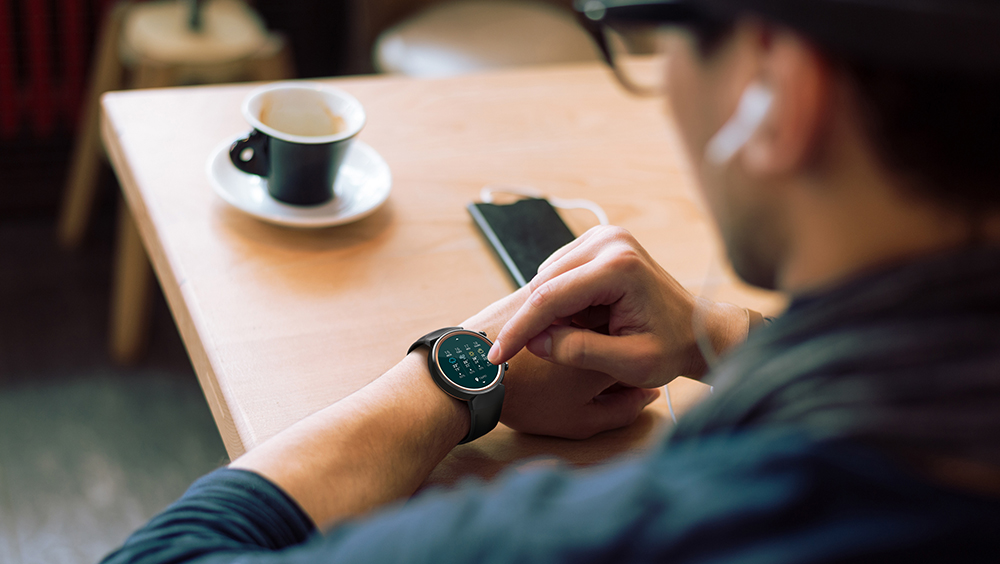Products in this test
When we tested the first smartwatch in 2013, we weren’t particularly impressed. They were bulky, hard to handle, the battery life was poor, and they couldn’t actually do much. Other than seeing what time it was,you could check messages and the weather, control music, and keep track of your workouts. Some had more experimental than practical features, like a built-in camera. The watches themselves have become better over the years, and have been given longer battery life, a more readable display, and lighter weight.
But the fundamental issue of first-generation modern watches was that you could not download apps. There were no operating systems for the watches, so every manufacturer used his own software, or utilized poorly adapted smartphone-OS, like Android. Naturally, third-party manufacturers were not particularly fond of spending time and money to adapt their apps to the countless clocks that existed out there. The time had come for standards.
Already in 2014, the problem resolved itself, although it also then split the market. We got a watch model by Tizen, that is supported by Intel and Samsung, among others. Naturally, it was the latter company that first came out with their Gear S2. That same year, Google launched its Android Wear, which is adapted to smartwatches. The first product was LG G Watch. Apple continued to remain isolated, until 2015, when they released the first Apple Watch with their own operating system WatchOS.
With a very similar format for watches, the same sensors and very similar electronics inside, the operating sstem the watch uses has therefore become important. The OS is what determines many of the features, management, and apps that one can use. So let’s go through the three contenders.
Tizen
An operating system based on Linux, developed by the Linux Foundation, Tizen Foundation, Intel and Samsung. It is used widely for embedding in smart home appliances, home electronics and even white good. But especially Samsung has additionally pushed for using it for cheap mobile phone models in developing countries as well as for smartwatches. Early versions suffered greatly from the lack of apps, but with time more well-known apps have been released. Today, it’s not a big deal, and all the essentials can be found like Spotify, SAS, Über, Shazam, Amazon Prime, Skype, Twitter, Office, Evernote, Kindle, Tripadvisor, Runtastic and Paypal. It’s fast, decent and has good integration between the mobile phone and the watch. The only real drawback is that it is mainly Samsung that invests in it.
WatchOS
Apple’s own watch operating system is based on iOS for the mobile phone. One noticed that very clearly in the first versions, where the interface was not fully thought out. Moreover, it was relatively resorce demanding, in that the watches felt slow and the battery died far too quickly. Version 3, which was released simultaneously with the second generation watch, is considerably more polished. The navigation is more intuitive and everything feels faster. At the same time, it doesn’t drain the battery as much. One major advantage is the offering of apps, partly due to the fact that developers can create so-called universal apps. They work on several types of devices, like the iPhone, iPad and Apple Watch. It’s clearly marked in the App Store, and also implies that one doesn’t have to buy an app multiple times. In a short time, WatchOS has evolved into the most mature operating system for watches, with the most features.
Android Wear
As its name implies, it is Google’s operating system that has its roots in the Android of mobile phones. It was released in 2014 as a solution to the problems manufacturers had with running custom Android versions in watches. The custom operating system had an interface that worked better on a small screen, support for the watch sensors, and worked with the electronics of many manufacturers. But it was far from perfect, and although it supported Google Now, it was mostly a one-way communication. However, one major advantage is that since 2015 it has actually worked well with the iPhone. Since then not much has happened other than that it now supports speakers and Wifi. Before now, as a major upgrade to version 2 has just been released. Many new watch models will appear, and it will be exciting to see what unexpected features the next generation of smartwatches have to offer.
In our mini-test of smart watches, we have examples of watches that run WatchOS, Tizen, Android Wear, and the first watch to be released in Scandinavia with Android Wear 2.
What’s new in Android Wear 2.0?
Better dials: Previously, the dial has only been able to display selected information such as date, battery level and training targets. The new dials can be tailored with information from apps such as the next meeting on the calendar, stock quotes or Quick buttons to book a taxi or start the training. Different dials can have different information so you can sweep between work, leisure or the gym.
The fitness app Google Fit can measure pace, distance, calorie burning, and pulse as you walk, jump or bike. Besides calculating push-ups and sit-ups, it can now also calculate repetitions with the barbell.
With a built-in Play Store in the watch, you can download Android Wear apps directly, even if it’s connected to an iPhone. If your watch has a built-in SIM card, you can also keep track of your calls and messages while streaming music directly to your watch, no matter where your phone is.
It’s easier to manage messages. Tap to read the entire message and choose between responding by dictation, keyboard, handwriting, or with the emoji character. One can even use smart auto reply that is customized to what is stated in the message.
The watch now has Google Assistant built-in so that one can use the voice to ask questions or give commands. One can, for example, use it for navigation, weather forecasts or restaurant bookings. So far only in English or German, but more languages are on the way.
Be aware that certain features require sensors or other hardware that your older watch may not have.
Existing watches that can be upgraded to Android Wear 2.0: ASUS ZenWatch 2 & 3, Casio Smart Outdoor Watch, Casio PRO TREK Smart, Fossil Q Founder, Fossil Q Marshal, Fossil Q Wander, Huawei Watch, LG G Watch R, LG Watch Urbane & 2nd Edition LTE, Michael Kors Access-smartwatches, Moto 360 2nd Gen, Moto 360 for Women, Moto 360 Sport, New Balance RunIQ, Nixon Mission, Polar M600 and TAG Heuer Connected.
Products in this test
Samsung Gear S3 Classic
Practical and Smart
Samsung’s best smartwatch so far, but it's already in arrears.


Huawei Watch 2
Connected and modern
Huawei gives it all regarding the latest technology, but loses points regarding style.


Asus ZenWatch 3
Stylish but slimmed down
An elegant watch at a good price, but one must live with some limitations.


Apple Watch series 2
Apple Watch is all grown up
If you have decided on a smartwatch, this is the best that is currently out there.



